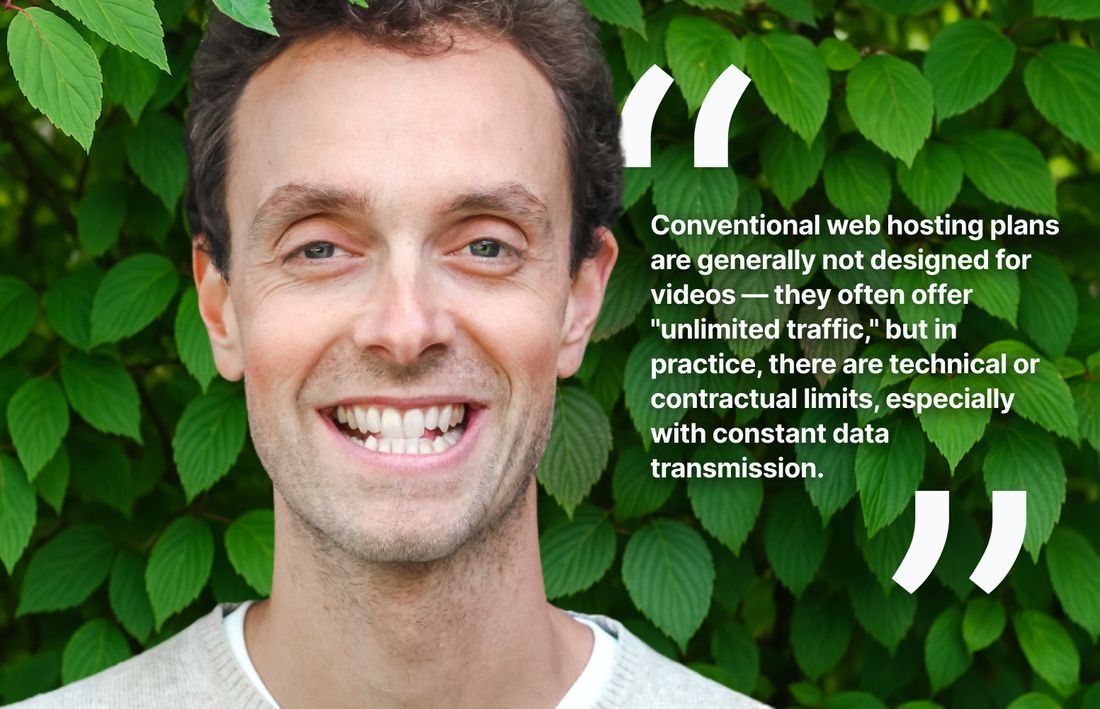
Video Hosting vs. Web Hosting: The Key Differences
Since 2006, Marco Keul has been leading hosttest.de, the premier web hosting comparison platform in the DACH region. Through annual "Webhoster of the Year" elections and his projects, Marco has gained in-depth insights into the challenges of video hosting.
We talk to him about the specific requirements of video hosting compared to standard web hosting and the differences that need to be considered.
#1 - Hey Marco, I'd like to start by discussing the specific requirements of video hosting compared to standard web hosting. What are the major differences we need to consider?
Sure! One of the most significant differences between traditional web hosting and specialized video hosting lies in the requirements for bandwidth, storage, and performance. Videos not only generate significantly more traffic, but they also demand high load speeds and streaming quality.
Classic web hosting packages are primarily designed for websites with text and images—so, for relatively small files and less data-intensive access. If you simply upload large video files to your webspace, you can quickly encounter problems: either with performance, load times, or due to technical limits like traffic throttling or lack of support for adaptive streaming formats like HLS.
Therefore, true video hosting often requires specialized solutions—either through external platforms or through own server setups that are optimized for streaming.
#2 - Can you discuss performance as one of the main differences?
Absolutely—performance is a central aspect that significantly sets video hosting apart from traditional web hosting. Once videos are being streamed, a very stable and powerful infrastructure is crucial.
Bandwidth plays a major role for one. A single HD or 4K stream can quickly require several megabits per second. When many users access videos simultaneously, this demand multiplies. Conventional web hosting plans are generally not designed for this—they often offer "unlimited traffic," but in practice, there are technical or contractual limits, especially with constant data transmission.

Additionally, a high-performance network is required, ideally one that utilizes a CDN (Content Delivery Network) to distribute content geographically. This is the only way to keep buffering times and latency low—especially when viewers from different regions access the videos. The server hardware itself must also keep up, for instance during simultaneous transcoding processes or peak loads.
Thus, anyone serious about video hosting cannot avoid a professional hosting infrastructure.
#3 - What are the options for ensuring scalability, especially when demand increases?
Scalability is a key issue in video hosting—especially when access numbers fluctuate dramatically or suddenly spike. To be prepared for such peaks, there are several options.
A proven approach is the use of a Content Delivery Network (CDN). This system doesn't just deliver videos from one central server, but from many distributed nodes around the world. This alleviates the load on your own infrastructure, reduces load times, and ensures a consistently good user experience regardless of whether someone is accessing a video from Germany, the USA, or Asia.
Additionally, many providers rely on cloud-based solutions that can dynamically allocate resources. This means that as demand increases, additional capacities, such as computing power or bandwidth, are automatically added. This is crucial for international video platforms to maintain flexibility and reliability.
Those who anticipate growing demand should therefore opt for a scalable architecture from the outset, whether through a CDN, a cloud solution, or a combination of both.
#4 - Can you give us an overview of the key KPIs in hosting? Specifically relating to videos.
Certainly—a brief overview of the key KPIs in hosting, especially with a focus on video content, is definitely useful. With videos, it's not just about whether they play or not, but about many technical details that directly impact the user experience.
Here are a few crucial metrics:
Load Time (Time to First Byte / Start Delay)
The faster a video starts, the better. Long load times lead to drop-offs, especially on mobile devices.
Bitrate / Adaptive Streaming
The average bitrate provides information about video quality. It's important that the system offers various resolutions so that smooth streaming is possible even with a weak connection.
Traffic – Volume & Peaks
How much data volume is being used? And how much do access numbers fluctuate at certain times? This information helps to properly plan and scale the infrastructure.
Buffering Ratio
How often does the video need to reload? A high value indicates performance issues, such as insufficient bandwidth or an overloaded network.
Availability / Uptime
The platform should be available as much as possible. 99.9% availability is often the minimum standard, and for professional video hosting, it's usually even higher.
Viewer Engagement / Watch Time
Time Although more of a business KPI, it's closely linked to hosting performance: if users drop off, it could also be due to technical issues.
#5 - You review many web hosts on your site, what do you focus on?
In our web hosting comparison, we place great importance on tangible, understandable criteria—especially on cost and scope of services. These are the points most of our visitors filter by when they are looking for a suitable hosting offer. After all, the offer should not only technically fit, but also be economically sensible.
Additionally, in our web hosting tests, we go a step further and examine aspects that are not immediately apparent—such as performance and availability or the quality of customer support. Because in the end, it's not just what's on paper that counts, but also how reliable and competent a provider is in everyday situations.
Our goal is to provide a solid basis for decision-making with objective comparative data and practical experience, whether for classic websites, online stores, or for specialized applications like video hosting.

Thanks.
Thank you, Marco, for the deep insights and practical tips about video hosting!
For more about Marco and his projects, follow these links:
Video-Hosting in Europe
To empower brands to realize the full potential of their video content, we made video hosting & streaming cookie- and consent-free. GDPR-compliant, hosted in Europe & easy to integrate. Made for Europe.